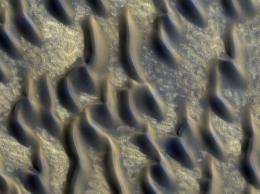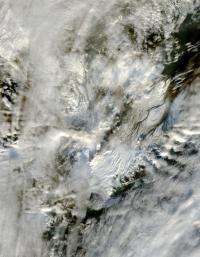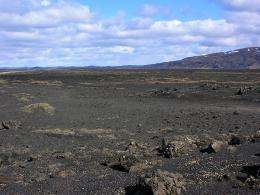Martian volcanic glass could be hotspot for life

Water may have played a role in forming plains of volcanic glass that spread across nearly a third of Mars. The discovery of this volcanic glass could steer scientists toward subglacial lakes where martian life could thrive.
Glass sand on Mars may point the way to chemically-rich water ideal for hosting life. The newly discovered glass dune fields, spread across almost a third of the planet, likely formed from interactions between magma and ice or water - interactions that could create the perfect environments for microbial life.
A glassy sea of sand
The northern lowlands spread across millions of square miles in the red planet's northern hemisphere. But dark sediments in the region have puzzled planetary scientists.
Briony Horgan and James Bell, both of Arizona State University, used the European Space Agency's Mars Express orbiter to re-examine light radiated from the martian plains. They determined that the strange readings were caused by sand composed of glass.
"We're actually seeing glass particles, like glass sand," Horgan said.
Such landforms are not unique to Mars. Iceland boasts thousands of square miles of desert dominated by glass sand.
The martian dunes don't just make an interesting vacation spot. They also provide tantalizing hints toward their formation.
"The only way to create an extensive glassy deposit like that is through explosive volcanism," Horgan said. "This is the first direct evidence on Mars for explosive volcanism on a planetary scale."

When a Martian volcano erupts, the thin atmosphere and difference in pressure should make for some great pyrotechnics. But a fiery eruption alone won't guarantee glass. It takes an interaction with water or ice to manage that.
"When lava or magma interacts with ice or water, it is quenched, which means it rapidly cools and solidifies," said Claire Cousins of the University of London. "This rapid cooling prevents any crystals from growing, and so a volcanic glass is produced."
Cousins, who was not involved in the new research, has studied volcanic environments in Iceland and Antarctica as martian analogues, and is investigating subglacial volcanoes on Earth as habitats for life.
The glassy plains also show evidence of water-related weathering. As ice melted across the lowlands, it mixed with the strange sand to form an acid. With enough exposure to the iron inside the sand, the chemicals would neutralize, which means that only a constantly renewed water source, like melting ice or snow, could cause the leaching the team saw.
Details on the new martian landforms were published online in the journal Geology.
A hotspot for life
The glassy expanse would not be the best location to search for life. But it could lead to more promising environments.
"We definitely know searching for organisms in the northern lowlands is difficult," Horgan said. "I think the better place to go would be those source regions, the ice-magma interactions."
Referring to hydrothermal systems and subglacial lakes, she said, "Those have been identified as places where biosignatures could have been preserved."
Cousins agreed.
"Regions of volcano-ice interactions on Earth provide a wide range of hydrothermal environments that can be exploited by microbial life," she said.

If a volcano erupts beneath a glacier, the heat could form huge subglacial lakes.
"It's the perfect place for microbes," Horgan said. "A nice, warm, safe place for microbes to hang out, with lots of chemicals around to munch on."
Locating the lakes
Finding such water sources could prove to be a challenge. After a volcanic explosion, the newly-created sand could fall from the sky. But although scientists have modeled a number of possibilities, they haven't quite been able to make the sand spread across the lowlands.
"There's only a couple of ways to move this stuff around," Horgan said.
Sand-sized ash is too heavy to travel far from the vents. The northern highlands are hundreds to thousands of miles from known volcanoes, however, which has left scientists puzzled.
The glass sand could provide a valuable clue. Because it requires ice or water to form, the subglacial lakes they suggest could solve part of the distribution problem.
Though the water would initially be contained - and ripe for life - eventually it could break free of the walls containing it, creating enormous floods across the lowlands.
"This would be similar to some of the catastrophic floods people have talked about for Mars."
The presence of glass sand, and their requirement of water to form, bring a clearer understanding to the geology of the red planet, and a more concrete suggestion on where to look for life.
"It's the first time we've really seen evidence for ice-related alterations on Mars," Horgan said.
"It's something we're really excited to look into."
More information: Paper online: geology.gsapubs.org/content/ea … /2012/03/23/G32755.1
Source: Astrobio.net




















